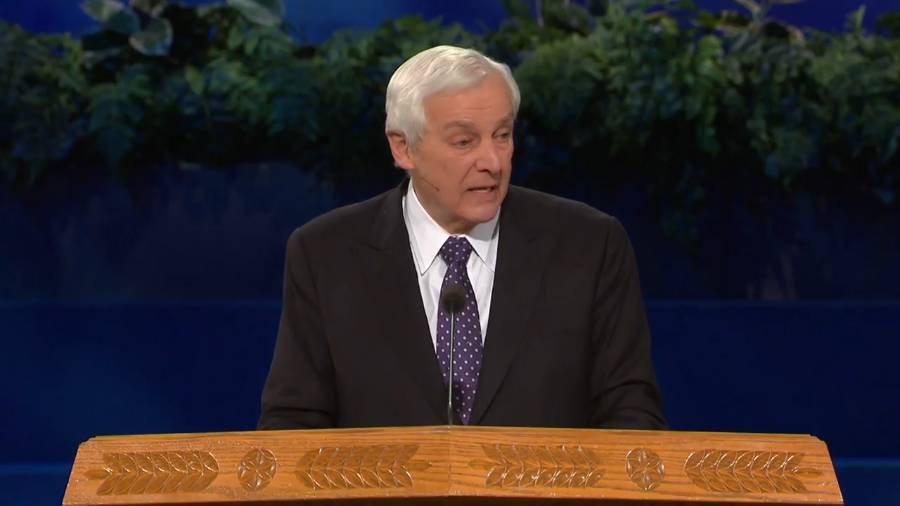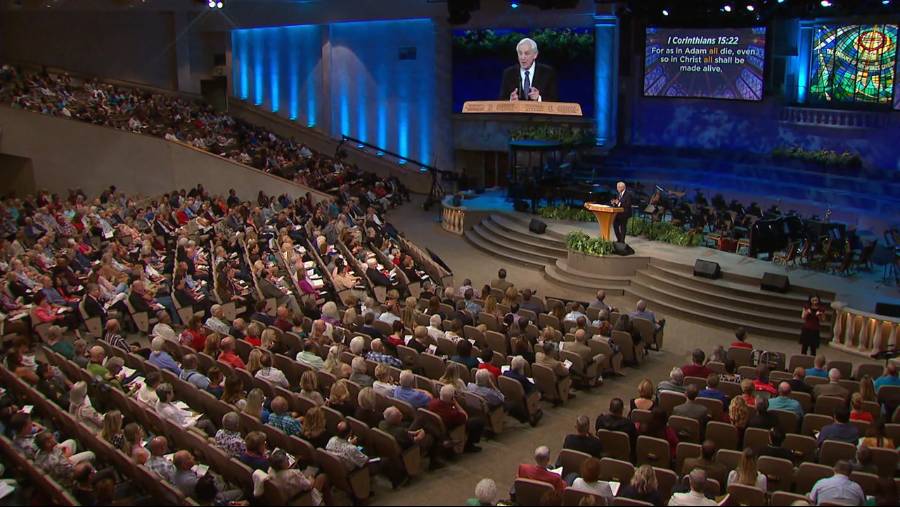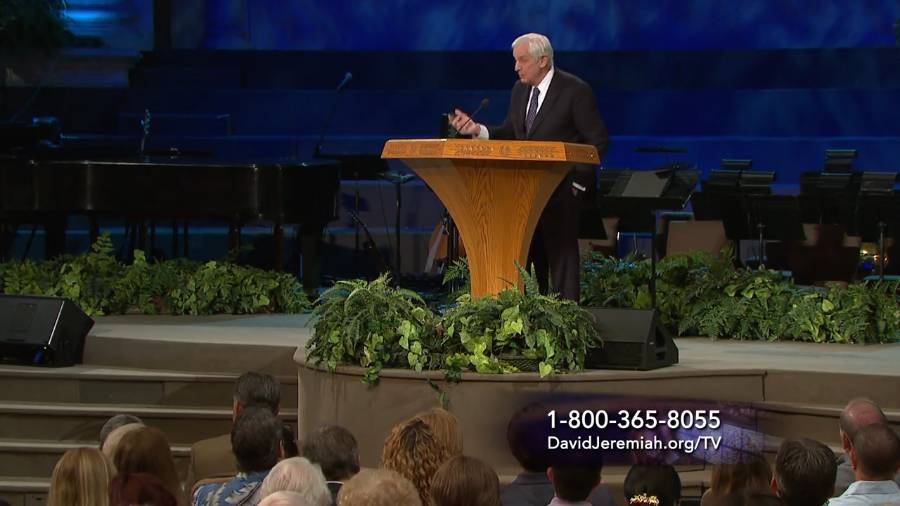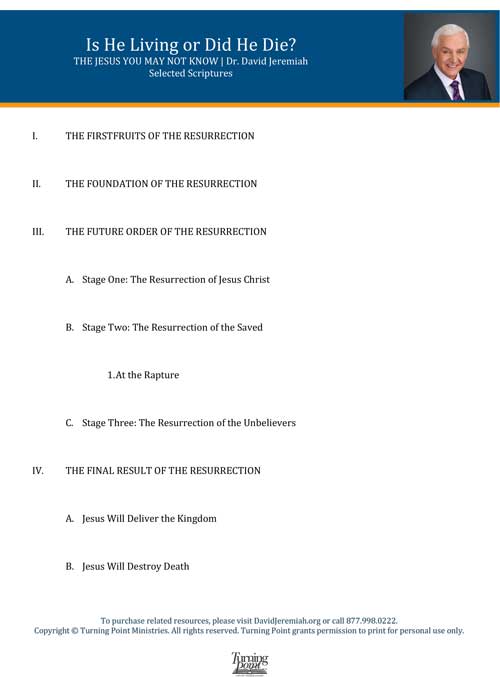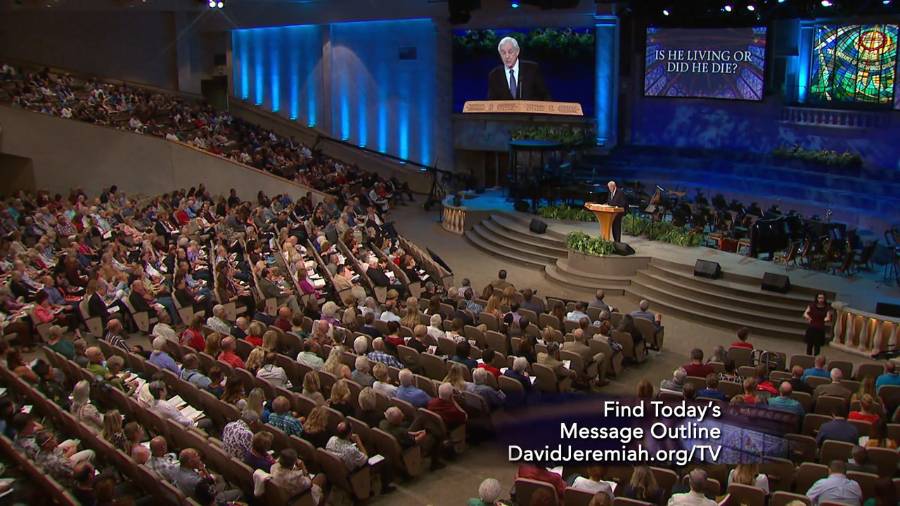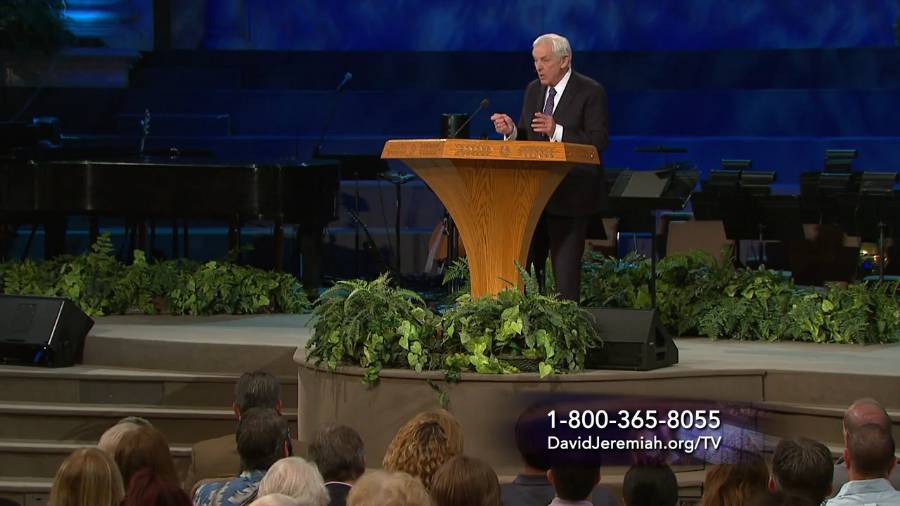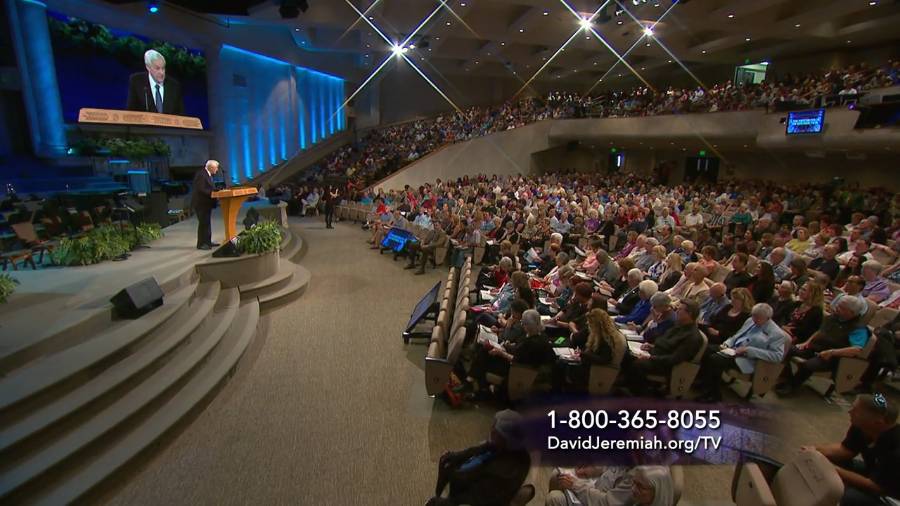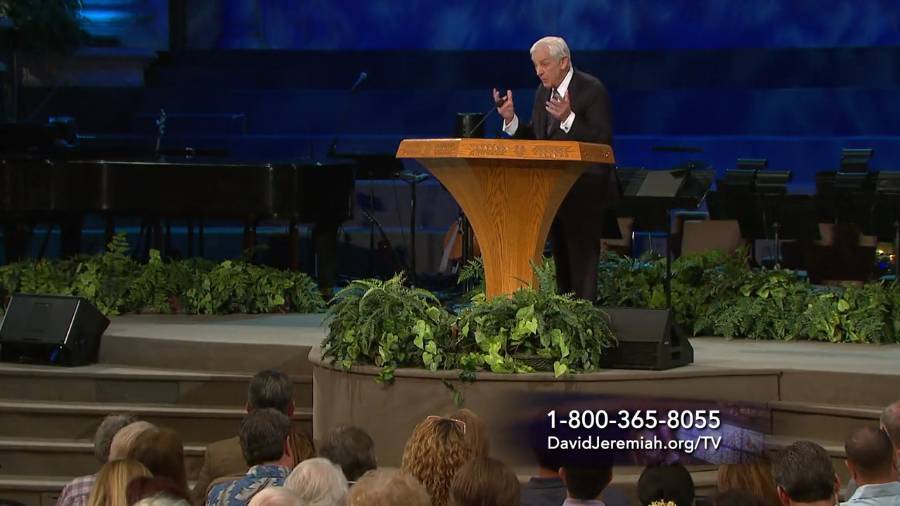The Jesus You May Not Know
Learn toFathomJesus like never before
Resources from David Jeremiah to aid in your journey from knowing about Jesus to knowing Jesus.
Is He Living or Did He Die?
Thanks for downloading your free resource!
Thanks for downloading your free resource!

Seven Signs That Jesus Rose From the Dead
By David Jeremiah
Every year thousands of people travel to the Italian Alps to ascend a mountain that passes through the “stations of the cross.” Eventually they come to the foot of an outdoor crucifix where they meditate on their faith. One day a tourist noticed a trail leading away from the cross. Determined to find out where it would lead, he fought through the thicket that surrounded the path; and to his surprise, he came to the next shrine—a shrine that symbolized the empty tomb. But the brush had grown up around it due to neglect. Almost every visitor had traveled as far as the cross—and then stopped.
The same is true for many in our world today. Even devout churchgoers tend to focus on the crucifixion of Jesus Christ as the key element of the Gospel. Not to diminish the cross, because the cross is critically important, but if Jesus Christ simply died and was buried and did not come back from the grave, then He could not be the Savior of the world any more than you or I could. But if Jesus came back from the grave, He has made a statement worth listening to.
So how do we know the Resurrection is an actual, historical event? And can it be supported by evidence?
In the Gospels, there are seven crucial signs that prove Jesus Christ rose from the dead.
The Signs
The story begins in Matthew 27 after the crucifixion of Christ has taken place. Joseph of Arimathea and Nicodemus, two wealthy men, have claimed the body of Jesus and placed His body in an unused tomb. On the third day after His death, visitors to the tomb found evidence that has forever changed the nature of our world.
One — The Soldiers
Upon their arrival, the visitors would have been surprised to find the tomb unguarded, knowing soldiers had been stationed to guard it for at least three days. Why? Jesus had claimed that He would come back from the dead, and the Jewish authorities wanted to make sure no one could steal the body and make it appear that He had risen from the grave.
The chief priests and Pharisees gathered together to Pilate, saying, “Sir, we remember, while He was still alive, how that deceiver said, ‘After three days I will rise.’ Therefore command that the tomb be made secure until the third day, lest His disciples come by night and steal Him away, and say to the people, ‘He has risen from the dead.’ So the last deception will be worse than the first.” Pilate said to them, “You have a guard; go your way, make it as secure as you know how.” So they went and made the tomb secure, sealing the stone and setting the guard (Matthew 27:62–66).
A Roman guard unit consisted of sixteen soldiers. Usually, four of them would stand side by side in front of the object they were guarding and the other twelve would gather in a semi–circle behind them facing inward. While the four were guarding, oftentimes the other twelve were sleeping. And every four hours, the soldiers who were standing in front of that which they guarded would take their place in the circle and four fresh soldiers would stand guard.
But when the women arrived that morning, there were no soldiers. Matthew 28:11 explains, “Now while they were going, behold, some of the guard came into the city and reported to the chief priests all the things that had happened.” What had happened? The tomb was empty. Jesus was gone.
When they had assembled with the elders and consulted together, they gave a large sum of money to the soldiers, saying, “Tell them, ‘His disciples came at night and stole Him away while we slept.’ And if this comes to the governor’s ears, we will appease him and make you secure.” So they took the money and did as they were instructed; and this saying is commonly reported among the Jews until this day (Matthew 28:12–15).
The idea that the disciples stole the body of Jesus explains the missing body, but the story fails to account for at least two factors: First, it is impossible to believe the soldiers would not have awoken as the disciples moved the stone away and stole the body of Jesus. In fact, twelve of them could have been sleeping, but four of them were supposed to be awake. And second, the real conundrum is this:
If the soldiers were all asleep, how did they know who stole the body?
Two — The Seal
Drawing closer to the tomb itself, the visitors notice the seal is also missing.
Matthew tells us, “They went and made the tomb secure, sealing the stone and setting the guard” (Matthew 27:66). After the stone was rolled in place, a rope was stretched across the stone and affixed with wax to each side of the tomb. Then a Roman guard placed his signet ring in the wax, signaling the sepulcher was officially sealed and contained what was purported to be inside. But when the women arrived at the tomb on that first Sunday, the stone had been rolled away, and the seal had been broken.
Three — The Stone
Surely the most startling sign would have been the gaping hole, for the stone that had covered the entrance to the tomb was missing.
When they sealed a sepulcher, a tomb, in the days of Jesus, the body of the deceased was placed inside a hewn–out stone. Then a piece of granite, usually in a round form, was rolled in front of the mouth of the tomb to keep animals from desecrating the corpse and to protect the dignity of the buried person. In front of the tomb, they would create a groove, an incline, and they would roll the stone up the incline and put a shim under it. After the burial, they would roll the stone in front of the grave and seal it to officially close the sepulcher.
But when the women came to the garden that day, there was no stone in front of the tomb. In fact, the Scripture explicitly describes what had happened:
Mary Magdalene and the other Mary came to see the tomb. And behold, there was a great earthquake; for an angel of the Lord descended from heaven, and came and rolled back the stone from the door, and sat on it (Matthew 28:1–2).
By reading the other Gospel accounts, we gain an even clearer picture of what happened that day. Mark tells us this stone was extremely large—twenty men could not move it. And according to John’s Gospel, John had to bend over to look inside when he arrived at the tomb.
Scholars believe the tomb in which Jesus was buried had an opening about 4½– to 5–feet high. Several studies have been conducted to determine how large the stone would have been in order to cover such an opening.
Conservative estimates indicate that the stone would have weighed 1½ to 2 tons.
But when the women arrived that day, the stone was not in front of the opening. It wasn’t even in the groove that had been placed there to help move the stone. John says, “The stone had been taken away from the tomb” (John 20:1). And the words John uses to describe the displacement of the stone mean “to pick something up and carry it away.”
The stone hadn’t been merely rolled back up the incline where it had started; it wasn’t near the opening of the grave. Rather, the stone was over by itself, as if someone had picked it up and moved it over. And then, of course, there was an angel sitting on top of it. Something miraculous was going on that day.
Four — The Sepulcher
Examining the tomb of Jesus, the visitors discover the fourth sign of the Resurrection: the sepulcher itself.
They found the stone rolled away from the tomb, but when they entered, they did not find the body of the Lord Jesus. While they were wondering about this, suddenly two men in clothes that gleamed like lightning stood beside them. In their fright the women bowed down with their faces to the ground, but the men said to them, “Why do you look for the living among the dead? He is not here; he has risen! Remember how he told you, while he was still with you in Galilee” (Luke 24:2–6, NIV).
When they looked inside the tomb, there was no body. Past the soldiers, past the seal, past the stone, and in the security of the sepulcher—Jesus’ body was gone.
Five — The Shroud
When Peter and John peered into the grave that day, the tomb was almost empty, but not quite. There wasn’t a body, but there was a shroud—the grave clothes were still there.
John 20:3–8 says:
Peter therefore went out, and the other disciple [John], and were going to the tomb. So they both ran together, and the other disciple outran Peter and came to the tomb first. And he, stooping down and looking in, saw the linen cloths lying there; yet he did not go in. Then Simon Peter came, following him, and went into the tomb; and he saw the linen cloths lying there, and the handkerchief that had been around His head, not lying with the linen cloths, but folded together in a place by itself. Then the other disciple, who came to the tomb first, went in also; and he saw and believed.
In Jesus’ day, people weren’t buried in robes; they were buried in layers of fabric, similar to what we would think of as a mummy, with spices wrapped between each layer of cloth. And as Peter and John peered into the grave where Jesus’ body had lain, they saw something startling.
There were the grave cloths that had encased Him, still in the shape of His body, slightly indented and caved in, like the empty chrysalis of a caterpillar’s cocoon.
That was enough evidence to make a believer out of anyone. And the Scripture says the sight of the empty grave cloths—undisturbed in their form and position—caused John to believe.
I don’t know exactly how their conversation went, but John’s explanation to Peter must have gone something like this:
Don’t you see, Peter? No one has moved the body or even disturbed the grave cloths. They’re lying exactly as Nicodemus and Joseph of Arimathea left them on the eve of the Sabbath. And the body is gone. It hasn’t been stolen. It’s not been moved. Clearly, His body had to have passed through the cloths, leaving them as we see them now. Jesus must be risen!
Theologian and teacher James Montgomery Boice commented on this fact:
This sign of Easter destroys the idea that the body was stolen. The linens would not have been there. This sign destroys the idea that Jesus resuscitated Himself and walked out of the grave. Leaving the grave clothes in the shape of His body in the tomb? A glance at these grave clothes proved the reality of the resurrection.1
Following that experience, John and his fellow disciples became courageous evangelists for the Gospel.
In fact, the Bible says these men of God turned their world upside down as a result of the Resurrection. And a careful reading of the book of Acts, which records the history of the early Church and the teaching of the apostles at that time, reveals that the Resurrection is the theme of every one of their messages. They were changed dramatically by what they saw at the tomb that day.
Six — The Scars
After the Resurrection, there was an occasion when Jesus’ apostles were gathered in the Upper Room and He appeared to them. The Bible says He did not come through the door; He just appeared. (Remember, Jesus was in His resurrection body.) All the disciples were present except for one, Thomas. After the meeting, the disciples told him about their encounter with the Risen Lord; but Thomas replied, “I won’t believe it until I see it myself.”
Eight days later, the Lord returned. This time Thomas was among the disciples.
After eight days His disciples were again inside, and Thomas with them. Jesus came, the doors being shut, and stood in the midst, and said, “Peace to you!” Then He said to Thomas, “Reach your finger here, and look at My hands; and reach your hand here, and put it into My side. Do not be unbelieving, but believing.” And Thomas answered and said to Him, “My Lord and my God!” (John 20:26–28)
Thomas knew he had seen the Risen Lord because of the scars in Jesus’ body.
Seven — The Sightings
Even beyond the scars, there is yet more evidence for our Risen Savior. After He was resurrected from the grave, Jesus didn’t immediately ascend to heaven. He spent several days here on this earth. And during that time, Jesus was not only seen by the apostles on two occasions in the Upper Room but also by men, women, children, individuals, and groups at various times of the day. In every situation you can imagine, Jesus Christ was seen. Paul records an occasion when Jesus revealed Himself to more than five hundred people, most of whom were still alive at the time Paul wrote his letter (1 Corinthians 15:6). Any of those people could have refuted his statement if they had chosen to do so. One writer has calculated that if all the witnesses who saw Jesus in His resurrected body were brought to court and given six minutes to speak, it would result in more than fifty hours of testimony about the Risen Christ.
The evidence for Christ’s resurrection is overwhelming! We can say with absolute certainty that Jesus Christ is alive. He overcame the grave. He walked the dusty streets of ancient Rome two thousand years ago, and He is living today at the right hand of the Father in heaven.
1James Montgomery Boice, The Gospel of John, vol. 5(Grand Rapids, Zondervan Press, 1979), 273.







